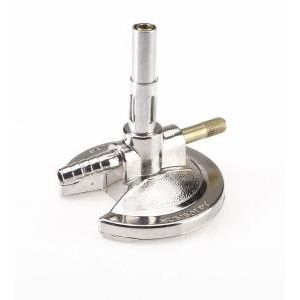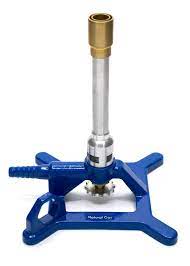A laboratory burner is a device used to produce a controlled flame for use in a laboratory setting. There are many different types of laboratory burners, each designed to meet specific needs.
How Does a Laboratory Burner Work?
A laboratory burner typically consists of a metal tube or nozzle through which gas flows, and a mechanism for igniting the gas. The gas is ignited by a spark or a flame, and the resulting flame is then directed through the nozzle.
The size and shape of the flame can be controlled by adjusting the flow of gas and the height of the burner. The temperature of the flame can also be controlled by adjusting the gas mixture.
Types of Laboratory Burners
There are many different types of laboratory burners, each designed for a specific purpose.
For example, Bunsen burners are often used for heating, drying, and pyrolysis. Meker burners are used for combustion and reduction reactions. Teclu burners are used for heating under vacuum.
Burner Suppliers
There are many companies that manufacture and supply laboratory burners. Some of the leading suppliers include:
- Fisher Scientific
- VWR International
- Thermo Scientific
- Sigma-Aldrich
- Corning
Bunsen Burner


A Bunsen burner is a device used in laboratories to heat small amounts of chemicals. It is named after its inventor, Robert Bunsen.
The Bunsen burner is a gas-fuelled device with a central tube that conducts the gas to a small metal nozzle. The nozzle is surrounded by a ceramic collar that can be adjusted to control the size of the flame. The gas is turned on and ignited at the nozzle, and the resulting flame is directed into the neck of the Bunsen burner.
The collar is used to regulate the flow of gas to the nozzle, and the size of the flame can be controlled by adjusting the distance between the nozzle and the collar. The Bunsen burner can be used to heat a small amount of chemical, to sterilize equipment, or to provide a source of heat for experiments.
The Bunsen burner was invented by Robert Bunsen in 1855. He was working on a method to determine the gas content of air, and he needed a way to heat a small sample of gas. He found that a small flame directed into the neck of a glass bottle would heat the gas and cause it to expand. This allowed him to measure the gas content of air more accurately.
The Bunsen burner is an important tool in laboratories, and it has been used for over 150 years. It is a simple and effective way to heat small amounts of chemicals and to sterilize equipment.
Micro Burner


A micro burner is a type of incense burner that is designed to hold smaller incense sticks. These burners are often made from ceramic or metal, and they often have a small bowl or cup on the top to catch the ashes that fall from the incense.
Micro burners are a great way to enjoy the benefits of incense without having to use a lot of it at once. They are also very portable, so you can take them with you when you travel.
If you are interested in trying a micro burner, there are a few things you should know before you get started.
What Are Micro Burners?
Micro burners are small incense burners that are designed to hold smaller incense sticks. These burners are often made from ceramic or metal, and they often have a small bowl or cup on the top to catch the ashes that fall from the incense.
Micro burners are a great way to enjoy the benefits of incense without having to use a lot of it at once. They are also very portable, so you can take them with you when you travel.
If you are interested in trying a micro burner, there are a few things you should know before you get started.
How to Use a Micro Burner
Using a micro burner is very similar to using a regular incense burner. First, fill the bowl or cup on the top of the burner with ashes. Then, light the incense stick and hold it upright in the ashes.
Allow the incense to burn for a few minutes, then blow it out. You can then enjoy the smell of the incense as it wafts through the room.
If you are using a micro burner for the first time, it is a good idea to start with a small amount of incense. This will help you get a feel for how long the incense needs to burn.
Keep in mind that micro burners can get very hot, so be careful not to touch them when the incense is lit.
Advantages of Micro Burners
There are many advantages to using a micro burner over a regular incense burner. First, micro burners are very efficient. Since they are designed to hold smaller incense sticks, you will use less incense overall.
This means that your incense will last longer, and you will save money in the long run.
Micro burners are also very convenient. They are small and portable, so you can take them with you when you travel. You can also use them in small spaces, such as in your office or in a hotel room.
Another advantage of micro burners is that they can help you control the amount of incense you use. If you find that you are using too much incense, you can simply use a smaller burner.
This will help you save money and incense, and it will also help you avoid using too much incense at once, which can be overwhelming.
Disadvantages of Micro Burners
There are a few disadvantages to using a micro burner. First, they can be more expensive than regular incense burners.
However, the long-term savings you will realize by using less incense will eventually offset the initial cost of the burner.
Second, micro burners can be more difficult to find than regular incense burners.
If you are having trouble finding a micro burner, you may want to try looking online. However, keep in mind that not all retailers will ship internationally, so you may need to find a retailer that is based in your country.
Finally, micro burners can be more delicate than regular incense burners.
If you drop a micro burner, it is more likely to break than a regular burner. Therefore, you will need to be careful when handling your micro burner.
Conclusion
Micro burners are a great way to enjoy the benefits of incense without having to use a lot of it at once. They are also very portable and convenient, making them a great choice for travel.
If you are interested in trying a micro burner, there are a few things you should know before you get started. Keep in mind that they can be more expensive than regular incense burners, and they may be more difficult to find.
But, if you are willing to pay a little extra and do a bit of research, you will be rewarded with a powerful and efficient incense burning experience.
Tirrill Burner


A tirrill burner is a type of burner used in some chemical laboratories. It consists of a tube with a small nozzle at one end and a heating element at the other. Tirrill burners are used to produce small, controlled flames for various purposes such as heating, soldering, and so on.
Advantages
There are several advantages to using a tirrill burner over other types of burners. One advantage is that the size of the flame can be easily controlled by adjusting the flow of gas through the burner. Another advantage is that tirrill burners can be used with a variety of gases, including oxygen, making them useful for a variety of applications. Finally, tirrill burners are relatively inexpensive and easy to use, making them a good choice for many laboratories.
Disadvantages
There are also some disadvantages to using tirrill burners. One disadvantage is that they can be dangerous if used improperly. Another disadvantage is that tirrill burners produce a lot of heat, which can be a problem in some applications. Finally, tirrill burners can be difficult to find in some parts of the world.
Alcohol burner


A laboratory alcohol burner is a small, portable burner that is used to heat small amounts of liquid in a laboratory setting. The burner is made of a metal wick that is dipped in alcohol, and the flame is produced by the vaporization of the liquid.
The laboratory alcohol burner is a versatile piece of equipment that can be used for a variety of tasks in the laboratory. The burner can be used to heat small volumes of liquids, to sterilize equipment, and to produce a flame that is hot enough to ignite chemicals.
The burner is easy to use and is a safe source of heat for the laboratory. The metal wick is dipped in alcohol, and the flame is produced by the vaporization of the liquid. The flame can be adjusted by the user, and the burner is safe to use if the instructions are followed.
The laboratory alcohol burner is an essential piece of equipment for any laboratory, and it is a versatile and safe source of heat.
